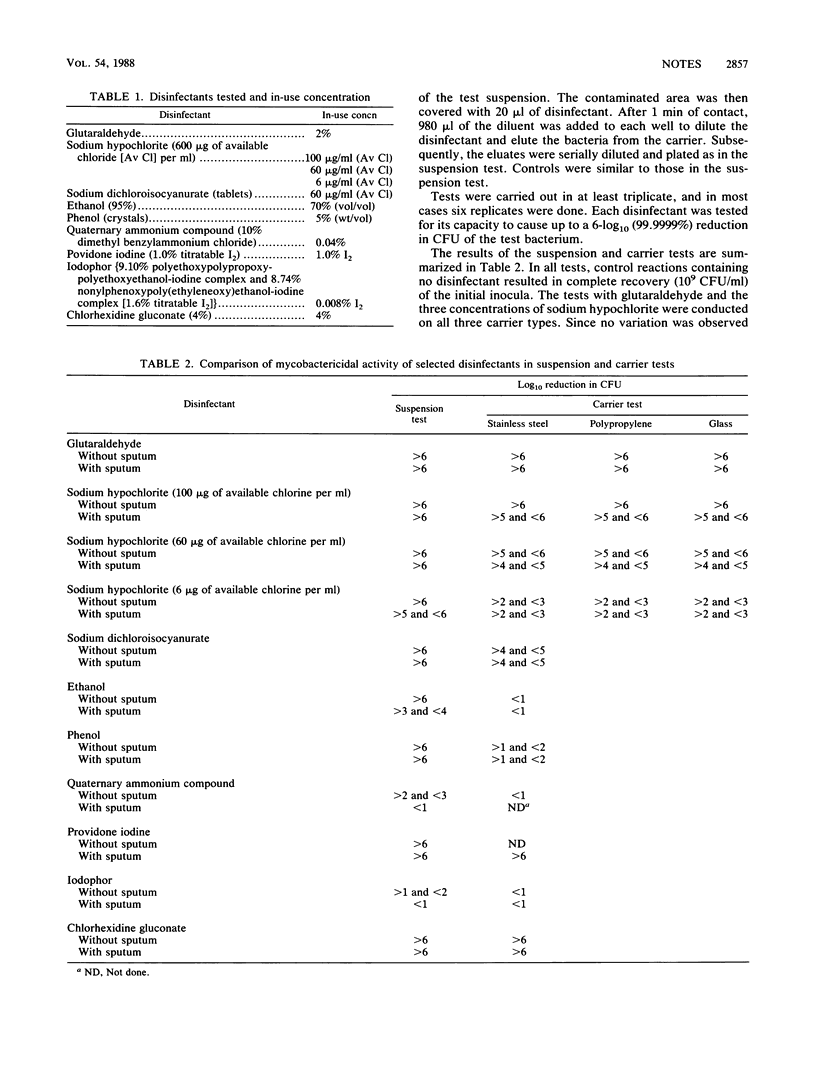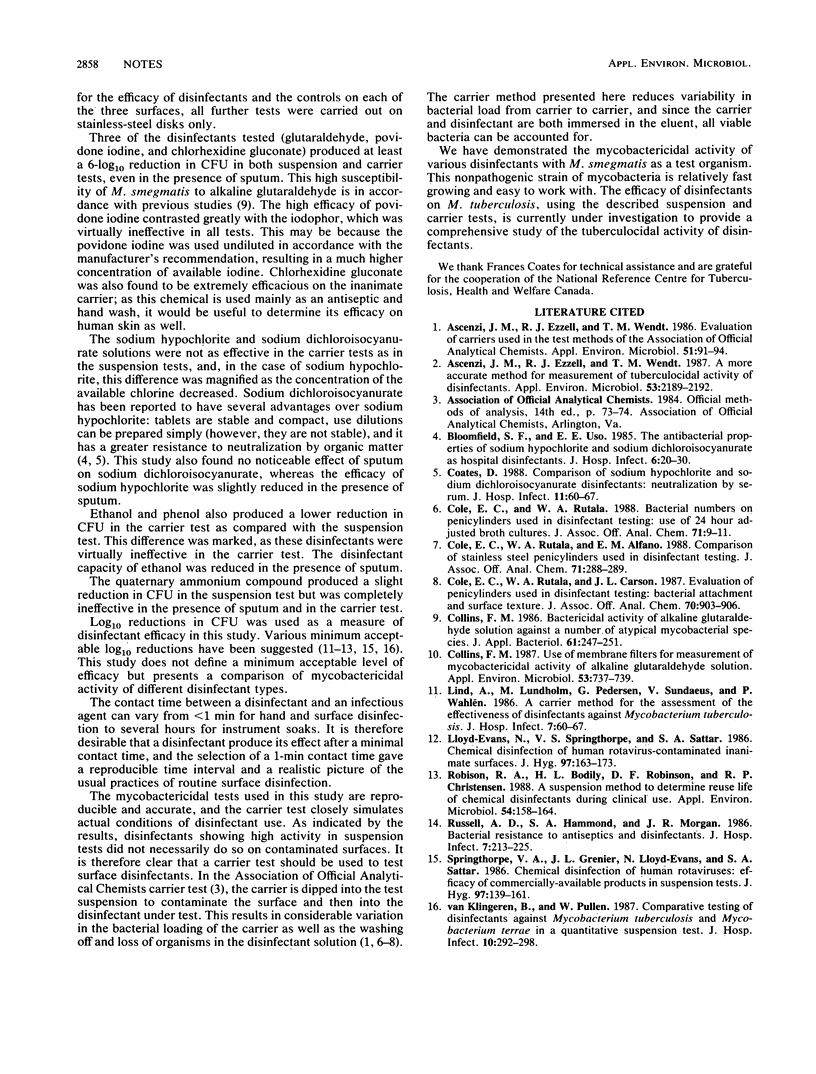Abstract
The efficacy of nine disinfectants on Mycobacterium smegmatis was tested in the presence of sputum, using quantitative suspension and carrier tests. Glutaraldehyde, povidone iodine, and chlorhexidine gluconate produced at least a 6-log10 reduction in CFU in all tests. Four disinfectants (sodium dichloroisocyanurate, phenol, ethanol, and sodium hypochlorite) were not as effective in the carrier tests as in the suspension tests; this difference ranged from a 1- to a 5-log10 reduction in CFU. The efficacy of ethanol and sodium hypochlorite was further reduced (3- and 1-log10 reductions in CFU, respectively) in the presence of sputum. The quaternary ammonium compound and iodophor were ineffective in all tests. The findings of this study demonstrate the need for a quantitative carrier test such as the one presented here.
Full text
PDF


Selected References
These references are in PubMed. This may not be the complete list of references from this article.
- Ascenzi J. M., Ezzell R. J., Wendt T. M. A more accurate method for measurement of tuberculocidal activity of disinfectants. Appl Environ Microbiol. 1987 Sep;53(9):2189–2192. doi: 10.1128/aem.53.9.2189-2192.1987. [DOI] [PMC free article] [PubMed] [Google Scholar]
- Ascenzi J. M., Ezzell R. J., Wendt T. M. Evaluation of carriers used in the test methods of the Association of Official Analytical Chemists. Appl Environ Microbiol. 1986 Jan;51(1):91–94. doi: 10.1128/aem.51.1.91-94.1986. [DOI] [PMC free article] [PubMed] [Google Scholar]
- Bloomfield S. F., Uso E. E. The antibacterial properties of sodium hypochlorite and sodium dichloroisocyanurate as hospital disinfectants. J Hosp Infect. 1985 Mar;6(1):20–30. doi: 10.1016/s0195-6701(85)80014-1. [DOI] [PubMed] [Google Scholar]
- Coates D. Comparison of sodium hypochlorite and sodium dichloroisocyanurate disinfectants: neutralization by serum. J Hosp Infect. 1988 Jan;11(1):60–67. doi: 10.1016/0195-6701(88)90040-0. [DOI] [PubMed] [Google Scholar]
- Cole E. C., Rutala W. A., Alfano E. M. Comparison of stainless steel penicylinders used in disinfectant testing. J Assoc Off Anal Chem. 1988 Mar-Apr;71(2):288–289. [PubMed] [Google Scholar]
- Cole E. C., Rutala W. A. Bacterial numbers on penicylinders used in disinfectant testing: use of 24 hour adjusted broth cultures. J Assoc Off Anal Chem. 1988 Jan-Feb;71(1):9–11. [PubMed] [Google Scholar]
- Cole E. C., Rutala W. A., Carson J. L. Evaluation of penicylinders used in disinfectant testing: bacterial attachment and surface texture. J Assoc Off Anal Chem. 1987 Sep-Oct;70(5):903–906. [PubMed] [Google Scholar]
- Collins F. M. Bactericidal activity of alkaline glutaraldehyde solution against a number of atypical mycobacterial species. J Appl Bacteriol. 1986 Sep;61(3):247–251. doi: 10.1111/j.1365-2672.1986.tb04283.x. [DOI] [PubMed] [Google Scholar]
- Collins F. M. Use of membrane filters for measurement of mycobactericidal activity of alkaline glutaraldehyde solution. Appl Environ Microbiol. 1987 Apr;53(4):737–739. doi: 10.1128/aem.53.4.737-739.1987. [DOI] [PMC free article] [PubMed] [Google Scholar]
- Lind A., Lundholm M., Pedersen G., Sundaeus V., Wåhlén P. A carrier method for the assessment of the effectiveness of disinfectants against Mycobacterium tuberculosis. J Hosp Infect. 1986 Jan;7(1):60–67. doi: 10.1016/0195-6701(86)90027-7. [DOI] [PubMed] [Google Scholar]
- Lloyd-Evans N., Springthorpe V. S., Sattar S. A. Chemical disinfection of human rotavirus-contaminated inanimate surfaces. J Hyg (Lond) 1986 Aug;97(1):163–173. doi: 10.1017/s0022172400064445. [DOI] [PMC free article] [PubMed] [Google Scholar]
- Robison R. A., Bodily H. L., Robinson D. F., Christensen R. P. A suspension method to determine reuse life of chemical disinfectants during clinical use. Appl Environ Microbiol. 1988 Jan;54(1):158–164. doi: 10.1128/aem.54.1.158-164.1988. [DOI] [PMC free article] [PubMed] [Google Scholar]
- Russell A. D., Hammond S. A., Morgan J. R. Bacterial resistance to antiseptics and disinfectants. J Hosp Infect. 1986 May;7(3):213–225. doi: 10.1016/0195-6701(86)90071-x. [DOI] [PubMed] [Google Scholar]
- Springthorpe V. S., Grenier J. L., Lloyd-Evans N., Sattar S. A. Chemical disinfection of human rotaviruses: efficacy of commercially-available products in suspension tests. J Hyg (Lond) 1986 Aug;97(1):139–161. doi: 10.1017/s0022172400064433. [DOI] [PMC free article] [PubMed] [Google Scholar]
- van Klingeren B., Pullen W. Comparative testing of disinfectants against Mycobacterium tuberculosis and Mycobacterium terrae in a quantitative suspension test. J Hosp Infect. 1987 Nov;10(3):292–298. doi: 10.1016/0195-6701(87)90012-0. [DOI] [PubMed] [Google Scholar]


